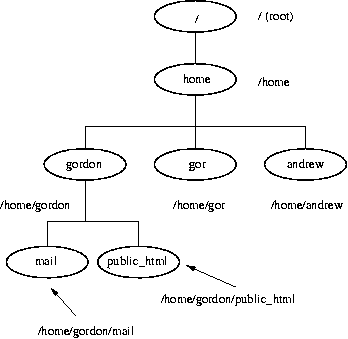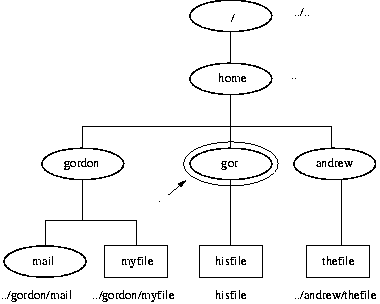If you can see this check that
| next section | prev section | up | prev page | next page |
To use an object, i.e. a file or directory within the file structure you must be able to locate that object. A path name describes the path that the operating system must take to get from some starting point in the file system to the destination object. In other words a path name is a chain of directory names that tell Unix how to locate an object, and where each object in the chain is separated by a slash character. An individual name (between slashes) may not exceed 255 characters and the entire path name may not exceed 1023 characters.
For example, in the figure below if we consider the directory 'john' and its path name from the rood directory '/' would be '/home/john'. The directories between the starting point (/) and the destination object is the directory 'home'. This type of path can be termed as an absolute path name. An absolute path name must begin with a /. Use the command 'pwd' to see your own absolute path of your current directory.

A relative path name on the other hand specified the path to a directory or file, starting from your current directory. It is in a sense a shortcut.

| Centos 7 intro: | Paths | BasicShell | Search |
| Linux tutorials: | intro1 intro2 wildcard permission pipe vi essential admin net SELinux1 SELinux2 fwall DNS diag Apache1 Apache2 log Mail |
| Caine 10.0: | Essentials | Basic | Search | Acquisition | SysIntro | grep | MBR | GPT | FAT | NTFS | FRMeta | FRTools | Browser | Mock Exam | |
| Caine 13.0: | Essentials | Basic | Search | |
| CPD: | Cygwin | Paths | Files and head/tail | Find and regex | Sort | Log Analysis |
| Kali 2020-4: | 1a | 1b | 1c | 2 | 3 | 4a | 4b | 5 | 6 | 7 | 8a | 8b | 9 | 10 | |
| Kali 2024-4: | 1a | 1b | 1c | 2 | 3 | 4a | 4b | 5 | 6 | 7 | 8a | 8b | 9 | 10 | |
| Useful: | Quiz | Privacy Policy | Terms and Conditions |
Linuxzoo created by Gordon Russell.
@ Copyright 2004-2025 Edinburgh Napier University